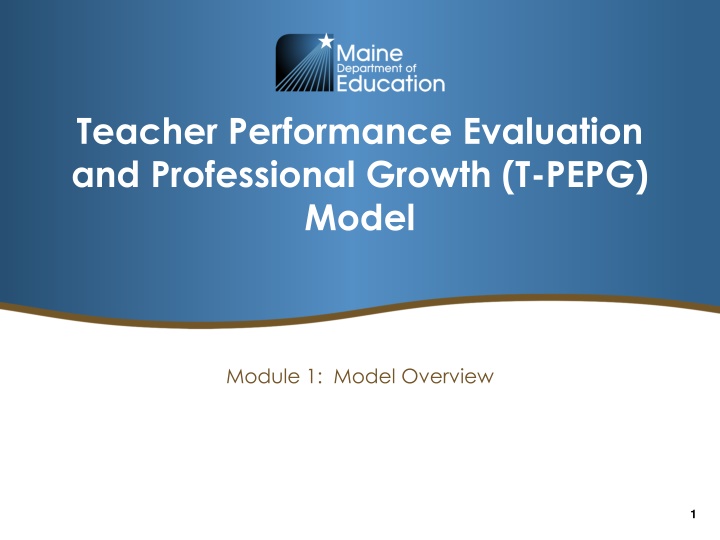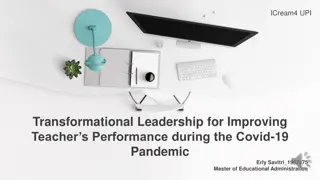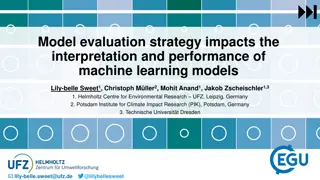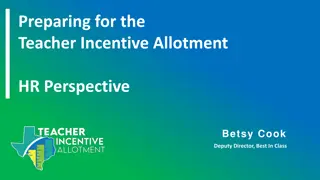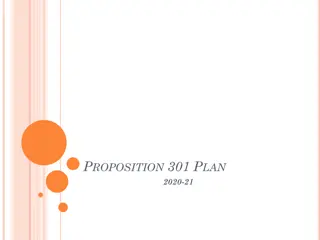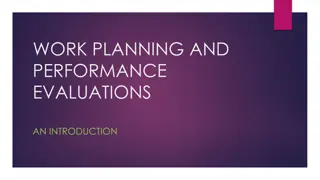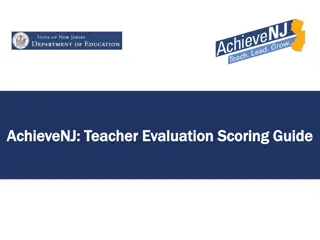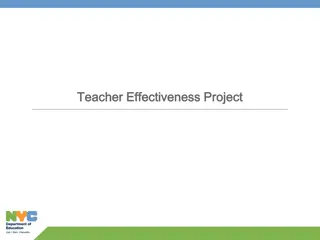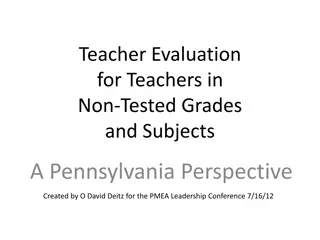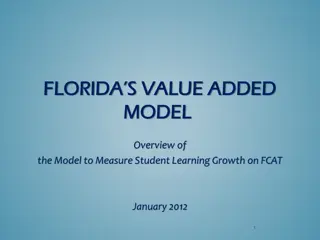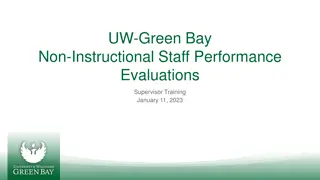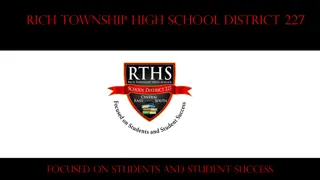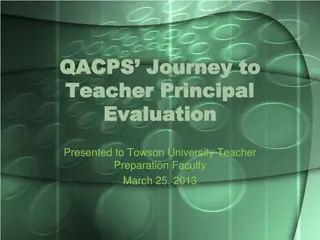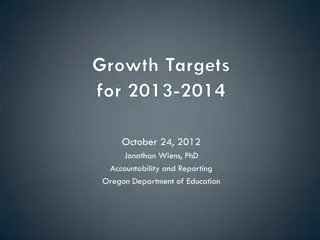Teacher Performance Evaluation and Professional Growth (T-PEPG) Model Overview
This training module provides an in-depth look at the Teacher Performance Evaluation and Professional Growth (T-PEPG) model, focusing on key features, structure, and terminology of the MSFE rubric. Participants will explore self-assessment, reflection, goal-setting, student learning objectives, evidence gathering, and feedback processes to enhance professional growth. The session aims to deepen understanding of evaluation standards, indicators, rubrics, and companion guides to improve instructional practices.
Download Presentation

Please find below an Image/Link to download the presentation.
The content on the website is provided AS IS for your information and personal use only. It may not be sold, licensed, or shared on other websites without obtaining consent from the author.If you encounter any issues during the download, it is possible that the publisher has removed the file from their server.
You are allowed to download the files provided on this website for personal or commercial use, subject to the condition that they are used lawfully. All files are the property of their respective owners.
The content on the website is provided AS IS for your information and personal use only. It may not be sold, licensed, or shared on other websites without obtaining consent from the author.
E N D
Presentation Transcript
Teacher Performance Evaluation and Professional Growth (T-PEPG) Model Module 1: Model Overview 1
Module 1: Model Overview Module 1: Model Overview The first module provides a big-picture overview of the key features of the T-PEPG model and unpacks the basic structure and terminology of the MSFE rubric by examining the rubric s standard indicators in preparation for self-assessment, reflection, and goal setting Module 2: Student Learning Objectives Module 3: Reflection and Goal-Setting Module 4: Evidence, Observation, and Feedback Module 5: Reflecting and Adjusting 2
Agenda Welcome (5 minutes) Connecting (10 minutes) Hopes and Worries Learning (50 minutes) T-PEPG Foundations, Elements, and Process Where Is the Rubric in the Four Step Evaluation Process? Getting to Know the Points of Contact Framework Implementing (55 minutes) The MSFE Rubric and Companion Guide Levels of Performance Taking a Deep Dive Into the Companion Guide Reflecting and Wrap-Up (5 minutes) Revisiting Hopes and Worries, Preparing for Module 2 3
Intended Outcomes At the end of this session, participants will know and be able to Understand the T-PEPG model foundation, elements, and four- step process Understand the NBPTS professional practice standards, indicators, and rubrics (MSFE Rubric), especially their structure and use in evaluation Use the Companion Guide to deepen familiarity with and understanding of the instructional and professional practices in the MSFE Rubric 4
Connecting 10 minutes CONNECTING 5
Connecting Activity: Hopes and Worries First sticky note: Write down your biggest hope for the new teacher evaluation model (e.g., what you hope you or your students might gain from it). Second sticky note: Write down your most significant worry or concern about the new model. 6
Learning: T-PEPG Foundations, Elements, and Process 50 minutes LEARNING 7
Why T-PEPG? Systematic changes to standards, curricula, instructional practice, and assessment will achieve little if efforts are not made to ensure every learner has access to highly effective teachers and school leaders. Maine DOE Education Evolving, 2012 8
T-PEPG Goals and Purpose Provide all students with effective teachers throughout their public school experience and improve student learning and growth by: Serving as the basis for professional development that can improve instructional effectiveness Clarifying expectations and serving as a guide for teachers as they reflect upon and improve their effectiveness. Facilitating collaboration by providing a common language to discuss performance Focusing the goals and objectives of schools and districts as they support, monitor, and evaluate their teachers Serving as a tool in developing structures of peer support for teachers Serving as a meaningful measurement of performance of individual teachers 9
The Professional Cohort Framework Focus: Aligned with 4- step evaluation process Mechanism for teacher training and critical review and approval of SLOs and professional goals. Purpose: Locus of support and training for teachers in achieving their professional goals and growing increasingly effective. Leadership: T-PEPG Lead (insert name) Professional Cohort Facilitators (insert name(s)) Selected based on administration s prior knowledge of teachers qualities and skills. 10
The Professional Cohorts for [Insert District] Topics (Year 1) T-PEPG overview (Insert Date, Location) Professional practice/Core Propositions (Insert Date, Location) SLO development (Insert Date, Location) Assessment selection (Insert Date, Location) Professional goal-setting (Insert Date, Location) SLO tuning, review, and approval (Insert Date, Location) Observation, review, and feedback (Insert Date, Location) Gathering evidence (Insert Date, Location) Data and reflection (Insert Date, Location) 11
National Board for Professional Teaching Standards: Five Core Propositions 1. Teachers are committed to students and their learning 2. Teachers know the subjects they teach and how to teach those subjects to students 3. Teachers are responsible for managing and monitoring student learning 4. Teachers think systematically about their practice and learn from experience 5. Teachers are members of learning communities 12
MSFE Rubric 1. Teachers are committed to students and their learning. 1.1 Understanding of Students 1.2 Application of Learning Theory 1.3 Classroom Climate 5. Teachers are members of learning communities. 5.1 Professional Collaboration 5.2 Engagement With Caregivers and Community Core Proposition 1 2. Teachers know the subjects they teach and how to teach those subjects to students. 2.1 Subject Knowledge 2.2 Pedagogical Content Knowledge 2.3 Goal-Focused Planning Core Core Proposition 2 Proposition 5 4. Teachers think systematically about their practice and learn from experience 4.1 Reflective Practice 4.2 Continuous Professional Growth 3. Teachers are responsible for managing and monitoring student learning. 3.1 Managing Classroom Routines and Expectations 3.2 Student Engagement 3.3 Assessment of Student Progress Core Core Proposition 3 Proposition 4 13
MSFE Rubric The five Core Propositions and 13 standard indicators align closely with the InTASC Model Core Teaching Standards as required by Chapter 180, Section 5. Four performance level definitions: 1. Ineffective 2. Developing 3. Effective 4. Distinguished 14
Multiple Measures of Effectiveness Core Propositions 1, 2, 3, and 5 Professional Practice Core Proposition 4 Professional Growth Student learning objectives Student Learning and Growth Student perception survey, not included until Year 3 Student Perception (Year 3) 15
The Four-Step Evaluation Process Step 1: Expectations and Goal- Setting Fall Step 2: Evidence, Feedback, and Growth Step 4: Professional Growth Plans Spring-Fall Fall-Spring Late Winter-Spring Step 3: Reflection and Rating 16
Point of Contact Framework Overview Point of Contact Menu Formal Observation Person to person Documented Evidence based Extended Classroom Observation Series of Informal Classroom Observations Video Lesson Review Curriculum Review Student Engagement Analysis Review of Student Learning Data Professionalism Observation/Conference Other 17
The Four-Step Evaluation Process Step 1: Expectations and Goal- Setting Fall Step 2: Evidence, Feedback, and Growth Step 4: Professional Growth Plans Spring-Fall Fall-Spring Late Winter-Spring Step 3: Reflection and Rating 18
Calculating the Summative Effectiveness Rating Professional Practice Rating (CPs 1, 2, 3, and 5) Rating of Impact on Student Learning and Growth Summative Effectiveness Rating Professional Growth Rating (CPs 4.1 and 4.2) Ineffective Partially Effective Effective Highly Effective Ineffective Developing Effective Distinguished Negligible Low Moderate High 19
The Four-Step Evaluation Process Step 1: Expectations and Goal- Setting Fall Step 2: Evidence, Feedback, and Growth Step 4: Professional Growth Plans Spring-Fall Fall-Spring Late Winter-Spring Step 3: Reflection and Rating 20
Professional Growth Plan Overview Self-Directed (Highly Effective/Effective) Monitored (Partially Effective) Directed (Ineffective) 3 years 2 years 1 year Two professional goals with a timeline from one to three years Two goals developed with support; aligned to the areas in need of improvement Goals aligned to areas in need of immediate improvement, timelines from 60 days to one year Professional Cohort may be outside of district School- or district-based Professional Cohort Administrator-approved Professional Cohort At least 2 SLOs per year At least 2 SLOs per year At least 2 SLOs Mid-cycle reflection Mid-cycle reflection Mid-cycle reflection 21
Implementation Timeline Year 1 (2015 2016) Summer: T-PEPG leads and cohort facilitators trained Fall: Professional cohorts begin; teachers set at least one SLO and related professional goals. Winter: Regular meetings of cohorts; begin points of contact Spring: Regular meetings of cohorts; continue points of contact Year 2 (2016 2017) Summer: T-PEPG leads and cohort facilitators trained Fall: New teachers trained; cohorts continue; second SLO and related professional goals developed; points of contact continue Winter/Spring: Self-evaluation and evidence submission Summary evaluation conferences held Every teacher receives summative effectiveness rating and is placed on a differentiated professional growth plan 22
Learning Activity 1a: Where Is the Rubric in the Four-Step Evaluation Process? Work with an elbow partner Turn to Handout 1 Sort the evaluation activities into the Four-Step Evaluation Process 23
The Rubric in the Four-Step Evaluation Process C F K H Step 1: Expectations and Goal- Setting Fall Step 2: Evidence, Feedback, and Growth Step 4: Professional Growth Plans D A E G Spring-Fall Fall-Spring Late Winter-Spring Step 3: Reflection and Rating B I J 24
Learning Activity 1b: Getting to Know the Points of Contact Framework Read and follow instructions in Handout 2 Work with a small group to complete the questions Share out 25
Break 26
Implementing: MSFE Rubric and Companion Guide 55 minutes 27
MSFE Rubric Core Proposition 1 Core Core Proposition 2 Proposition 5 Core Core Proposition 3 Proposition 4 Companion Guide, p. 3 28
MSFE Rubric Core Proposition Standard Indicator Performance Level Core Proposition 1 Performance Level Descriptions Italic = can be seen in instruction/ observation Bold = elements tied to planning or preparation Core Core Proposition 2 Proposition 5 Core Core Proposition 3 Proposition 4 Explanatory Notes 29
MSFE Rubric Companion Guide Descriptive Narrative Key Elements Questions for Reflection 30
Implementing Activity 1a: Levels of Performance Work with your table group Identify key words that are used across the performance level Record your responses on Handout 3 33
Learning Activity 1b: Taking a Deep Dive Into the Companion Guide Divide into 5 groups of 3 5 people each, working with teachers in a grade or subject area similar to your own. Each group will be assigned one Core Proposition. Assign each group member one standard indicator in the Core Proposition. Complete Handout 4. Step 1. Turn to the Effective level page for your standard indicator; read the level descriptor and the critical attributes. Jot down in your own words what the indicator is about. Step 2. Read through the Possible Examples ; choose one that resonates with your own classroom(s), and craft your example to share with your group. Step 3. Read the professional learning section and consider the follow-up questions in the handout. Step 4. Share out with your group. 34
Wrap-Up/Debrief From Activity 1b Discuss: How could the Companion Guide and this exercise be extended into existing collaborative opportunities at my school to ensure each teacher has a clear understanding of each Core Proposition and standard indicator? 35
Reflecting and Wrap-Up 5 minutes REFLECTING AND WRAP-UP 36
Revisiting Hopes and Worries Has your hope or worry changed? Why or why not? 37
Next Steps Bring some student data to Module 2, Student Learning Objectives, relevant to the class/course that will be the focus of your SLO. These data may include Student assessment scores from the prior year (both for classes you taught last year and test scores of your current students) Data from course pre-assessments Information on students with IEPs, 504 plans, and gifted and talented designations Course grades to date 38
Looking Forward to Module 2 Module 2 will provide details about the SLO process. Participants will engage in activities designed to increase their understanding of the SLO process and have time to begin drafting their SLOs for the 2015 2016 school year. 39
Presenter name XXX-XXX-XXXX xxxxxxxxxxx@xxx.xxx 1234 Street Address City, State 12345-1234 40
